Case Study on Pathophysiology of The Problem
VerifiedAdded on 2022/08/27
|11
|3013
|14
AI Summary
Contribute Materials
Your contribution can guide someone’s learning journey. Share your
documents today.

Running head: CASE STUDY
Case Study
Name of the Student
Name of the University
Author Note
Case Study
Name of the Student
Name of the University
Author Note
Secure Best Marks with AI Grader
Need help grading? Try our AI Grader for instant feedback on your assignments.
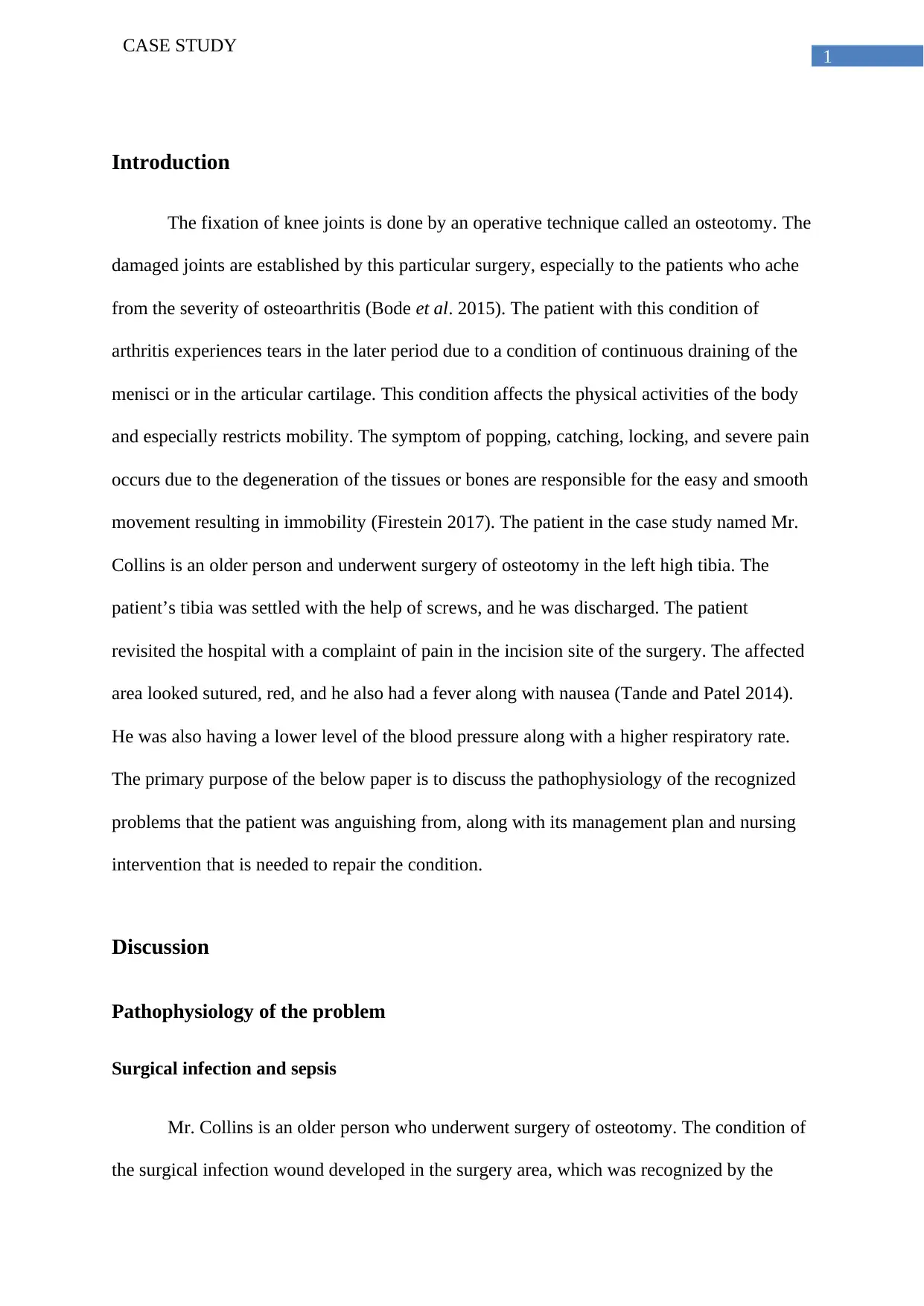
1
CASE STUDY
Introduction
The fixation of knee joints is done by an operative technique called an osteotomy. The
damaged joints are established by this particular surgery, especially to the patients who ache
from the severity of osteoarthritis (Bode et al. 2015). The patient with this condition of
arthritis experiences tears in the later period due to a condition of continuous draining of the
menisci or in the articular cartilage. This condition affects the physical activities of the body
and especially restricts mobility. The symptom of popping, catching, locking, and severe pain
occurs due to the degeneration of the tissues or bones are responsible for the easy and smooth
movement resulting in immobility (Firestein 2017). The patient in the case study named Mr.
Collins is an older person and underwent surgery of osteotomy in the left high tibia. The
patient’s tibia was settled with the help of screws, and he was discharged. The patient
revisited the hospital with a complaint of pain in the incision site of the surgery. The affected
area looked sutured, red, and he also had a fever along with nausea (Tande and Patel 2014).
He was also having a lower level of the blood pressure along with a higher respiratory rate.
The primary purpose of the below paper is to discuss the pathophysiology of the recognized
problems that the patient was anguishing from, along with its management plan and nursing
intervention that is needed to repair the condition.
Discussion
Pathophysiology of the problem
Surgical infection and sepsis
Mr. Collins is an older person who underwent surgery of osteotomy. The condition of
the surgical infection wound developed in the surgery area, which was recognized by the
CASE STUDY
Introduction
The fixation of knee joints is done by an operative technique called an osteotomy. The
damaged joints are established by this particular surgery, especially to the patients who ache
from the severity of osteoarthritis (Bode et al. 2015). The patient with this condition of
arthritis experiences tears in the later period due to a condition of continuous draining of the
menisci or in the articular cartilage. This condition affects the physical activities of the body
and especially restricts mobility. The symptom of popping, catching, locking, and severe pain
occurs due to the degeneration of the tissues or bones are responsible for the easy and smooth
movement resulting in immobility (Firestein 2017). The patient in the case study named Mr.
Collins is an older person and underwent surgery of osteotomy in the left high tibia. The
patient’s tibia was settled with the help of screws, and he was discharged. The patient
revisited the hospital with a complaint of pain in the incision site of the surgery. The affected
area looked sutured, red, and he also had a fever along with nausea (Tande and Patel 2014).
He was also having a lower level of the blood pressure along with a higher respiratory rate.
The primary purpose of the below paper is to discuss the pathophysiology of the recognized
problems that the patient was anguishing from, along with its management plan and nursing
intervention that is needed to repair the condition.
Discussion
Pathophysiology of the problem
Surgical infection and sepsis
Mr. Collins is an older person who underwent surgery of osteotomy. The condition of
the surgical infection wound developed in the surgery area, which was recognized by the
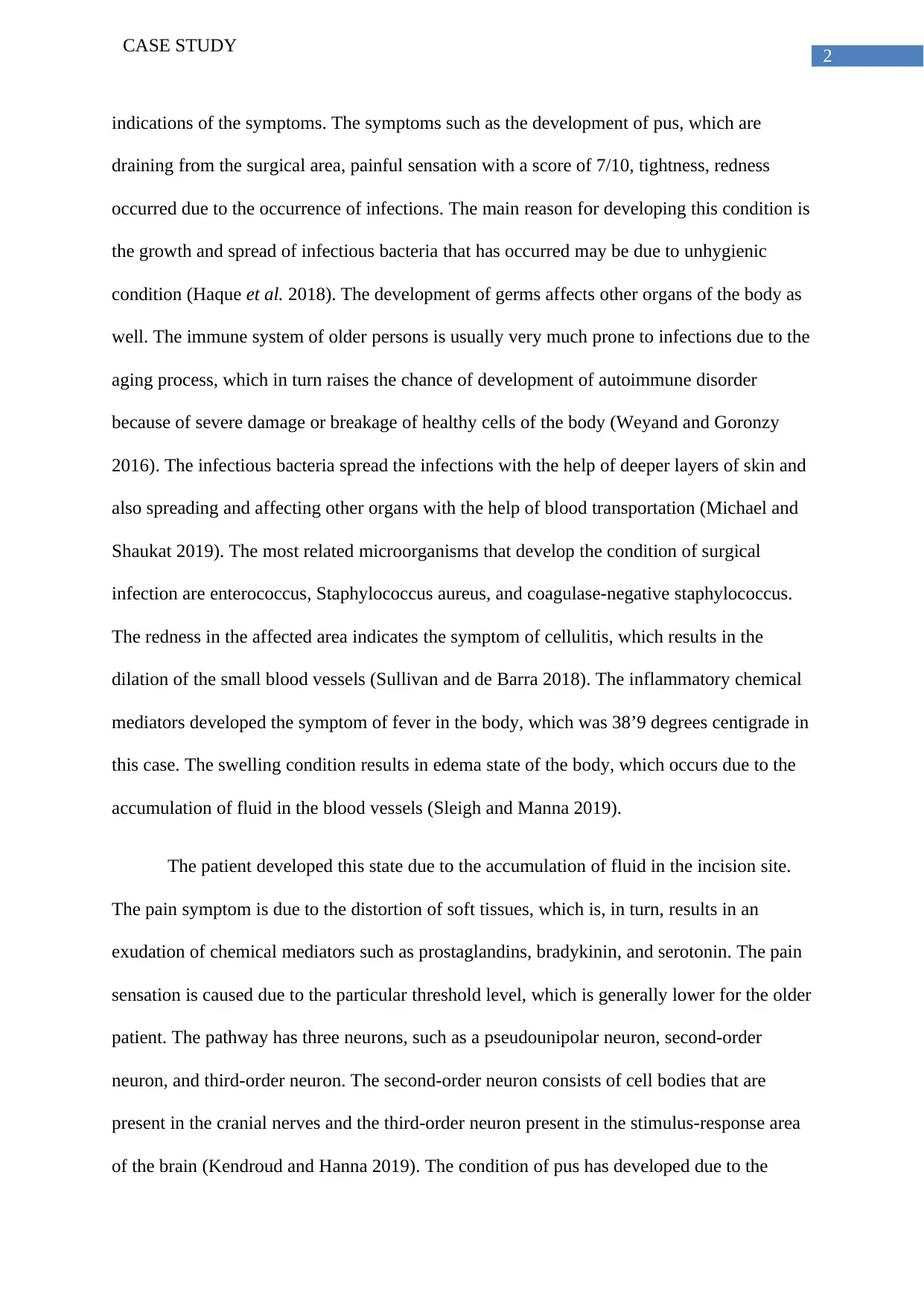
2
CASE STUDY
indications of the symptoms. The symptoms such as the development of pus, which are
draining from the surgical area, painful sensation with a score of 7/10, tightness, redness
occurred due to the occurrence of infections. The main reason for developing this condition is
the growth and spread of infectious bacteria that has occurred may be due to unhygienic
condition (Haque et al. 2018). The development of germs affects other organs of the body as
well. The immune system of older persons is usually very much prone to infections due to the
aging process, which in turn raises the chance of development of autoimmune disorder
because of severe damage or breakage of healthy cells of the body (Weyand and Goronzy
2016). The infectious bacteria spread the infections with the help of deeper layers of skin and
also spreading and affecting other organs with the help of blood transportation (Michael and
Shaukat 2019). The most related microorganisms that develop the condition of surgical
infection are enterococcus, Staphylococcus aureus, and coagulase-negative staphylococcus.
The redness in the affected area indicates the symptom of cellulitis, which results in the
dilation of the small blood vessels (Sullivan and de Barra 2018). The inflammatory chemical
mediators developed the symptom of fever in the body, which was 38’9 degrees centigrade in
this case. The swelling condition results in edema state of the body, which occurs due to the
accumulation of fluid in the blood vessels (Sleigh and Manna 2019).
The patient developed this state due to the accumulation of fluid in the incision site.
The pain symptom is due to the distortion of soft tissues, which is, in turn, results in an
exudation of chemical mediators such as prostaglandins, bradykinin, and serotonin. The pain
sensation is caused due to the particular threshold level, which is generally lower for the older
patient. The pathway has three neurons, such as a pseudounipolar neuron, second-order
neuron, and third-order neuron. The second-order neuron consists of cell bodies that are
present in the cranial nerves and the third-order neuron present in the stimulus-response area
of the brain (Kendroud and Hanna 2019). The condition of pus has developed due to the
CASE STUDY
indications of the symptoms. The symptoms such as the development of pus, which are
draining from the surgical area, painful sensation with a score of 7/10, tightness, redness
occurred due to the occurrence of infections. The main reason for developing this condition is
the growth and spread of infectious bacteria that has occurred may be due to unhygienic
condition (Haque et al. 2018). The development of germs affects other organs of the body as
well. The immune system of older persons is usually very much prone to infections due to the
aging process, which in turn raises the chance of development of autoimmune disorder
because of severe damage or breakage of healthy cells of the body (Weyand and Goronzy
2016). The infectious bacteria spread the infections with the help of deeper layers of skin and
also spreading and affecting other organs with the help of blood transportation (Michael and
Shaukat 2019). The most related microorganisms that develop the condition of surgical
infection are enterococcus, Staphylococcus aureus, and coagulase-negative staphylococcus.
The redness in the affected area indicates the symptom of cellulitis, which results in the
dilation of the small blood vessels (Sullivan and de Barra 2018). The inflammatory chemical
mediators developed the symptom of fever in the body, which was 38’9 degrees centigrade in
this case. The swelling condition results in edema state of the body, which occurs due to the
accumulation of fluid in the blood vessels (Sleigh and Manna 2019).
The patient developed this state due to the accumulation of fluid in the incision site.
The pain symptom is due to the distortion of soft tissues, which is, in turn, results in an
exudation of chemical mediators such as prostaglandins, bradykinin, and serotonin. The pain
sensation is caused due to the particular threshold level, which is generally lower for the older
patient. The pathway has three neurons, such as a pseudounipolar neuron, second-order
neuron, and third-order neuron. The second-order neuron consists of cell bodies that are
present in the cranial nerves and the third-order neuron present in the stimulus-response area
of the brain (Kendroud and Hanna 2019). The condition of pus has developed due to the
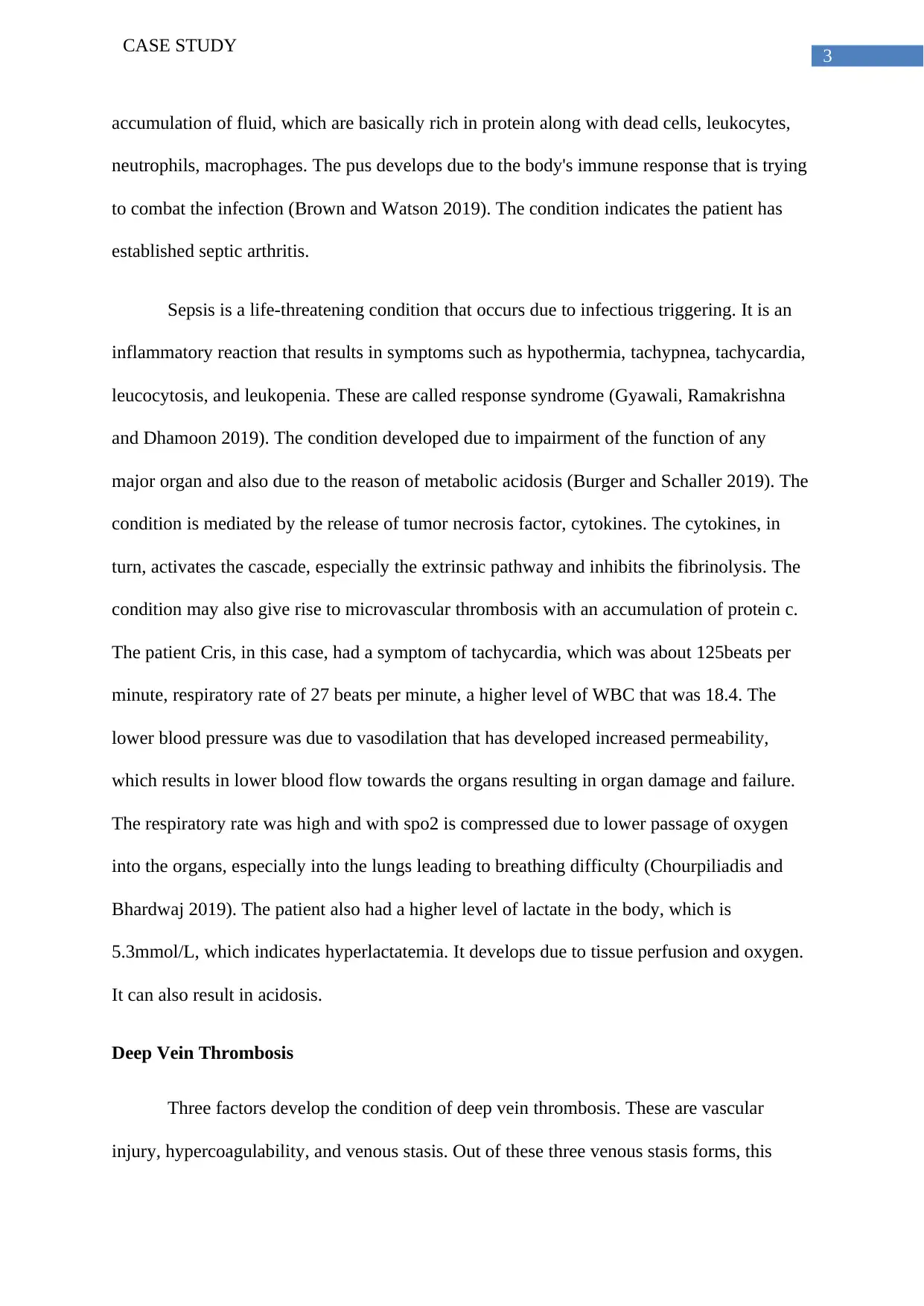
3
CASE STUDY
accumulation of fluid, which are basically rich in protein along with dead cells, leukocytes,
neutrophils, macrophages. The pus develops due to the body's immune response that is trying
to combat the infection (Brown and Watson 2019). The condition indicates the patient has
established septic arthritis.
Sepsis is a life-threatening condition that occurs due to infectious triggering. It is an
inflammatory reaction that results in symptoms such as hypothermia, tachypnea, tachycardia,
leucocytosis, and leukopenia. These are called response syndrome (Gyawali, Ramakrishna
and Dhamoon 2019). The condition developed due to impairment of the function of any
major organ and also due to the reason of metabolic acidosis (Burger and Schaller 2019). The
condition is mediated by the release of tumor necrosis factor, cytokines. The cytokines, in
turn, activates the cascade, especially the extrinsic pathway and inhibits the fibrinolysis. The
condition may also give rise to microvascular thrombosis with an accumulation of protein c.
The patient Cris, in this case, had a symptom of tachycardia, which was about 125beats per
minute, respiratory rate of 27 beats per minute, a higher level of WBC that was 18.4. The
lower blood pressure was due to vasodilation that has developed increased permeability,
which results in lower blood flow towards the organs resulting in organ damage and failure.
The respiratory rate was high and with spo2 is compressed due to lower passage of oxygen
into the organs, especially into the lungs leading to breathing difficulty (Chourpiliadis and
Bhardwaj 2019). The patient also had a higher level of lactate in the body, which is
5.3mmol/L, which indicates hyperlactatemia. It develops due to tissue perfusion and oxygen.
It can also result in acidosis.
Deep Vein Thrombosis
Three factors develop the condition of deep vein thrombosis. These are vascular
injury, hypercoagulability, and venous stasis. Out of these three venous stasis forms, this
CASE STUDY
accumulation of fluid, which are basically rich in protein along with dead cells, leukocytes,
neutrophils, macrophages. The pus develops due to the body's immune response that is trying
to combat the infection (Brown and Watson 2019). The condition indicates the patient has
established septic arthritis.
Sepsis is a life-threatening condition that occurs due to infectious triggering. It is an
inflammatory reaction that results in symptoms such as hypothermia, tachypnea, tachycardia,
leucocytosis, and leukopenia. These are called response syndrome (Gyawali, Ramakrishna
and Dhamoon 2019). The condition developed due to impairment of the function of any
major organ and also due to the reason of metabolic acidosis (Burger and Schaller 2019). The
condition is mediated by the release of tumor necrosis factor, cytokines. The cytokines, in
turn, activates the cascade, especially the extrinsic pathway and inhibits the fibrinolysis. The
condition may also give rise to microvascular thrombosis with an accumulation of protein c.
The patient Cris, in this case, had a symptom of tachycardia, which was about 125beats per
minute, respiratory rate of 27 beats per minute, a higher level of WBC that was 18.4. The
lower blood pressure was due to vasodilation that has developed increased permeability,
which results in lower blood flow towards the organs resulting in organ damage and failure.
The respiratory rate was high and with spo2 is compressed due to lower passage of oxygen
into the organs, especially into the lungs leading to breathing difficulty (Chourpiliadis and
Bhardwaj 2019). The patient also had a higher level of lactate in the body, which is
5.3mmol/L, which indicates hyperlactatemia. It develops due to tissue perfusion and oxygen.
It can also result in acidosis.
Deep Vein Thrombosis
Three factors develop the condition of deep vein thrombosis. These are vascular
injury, hypercoagulability, and venous stasis. Out of these three venous stasis forms, this
Secure Best Marks with AI Grader
Need help grading? Try our AI Grader for instant feedback on your assignments.
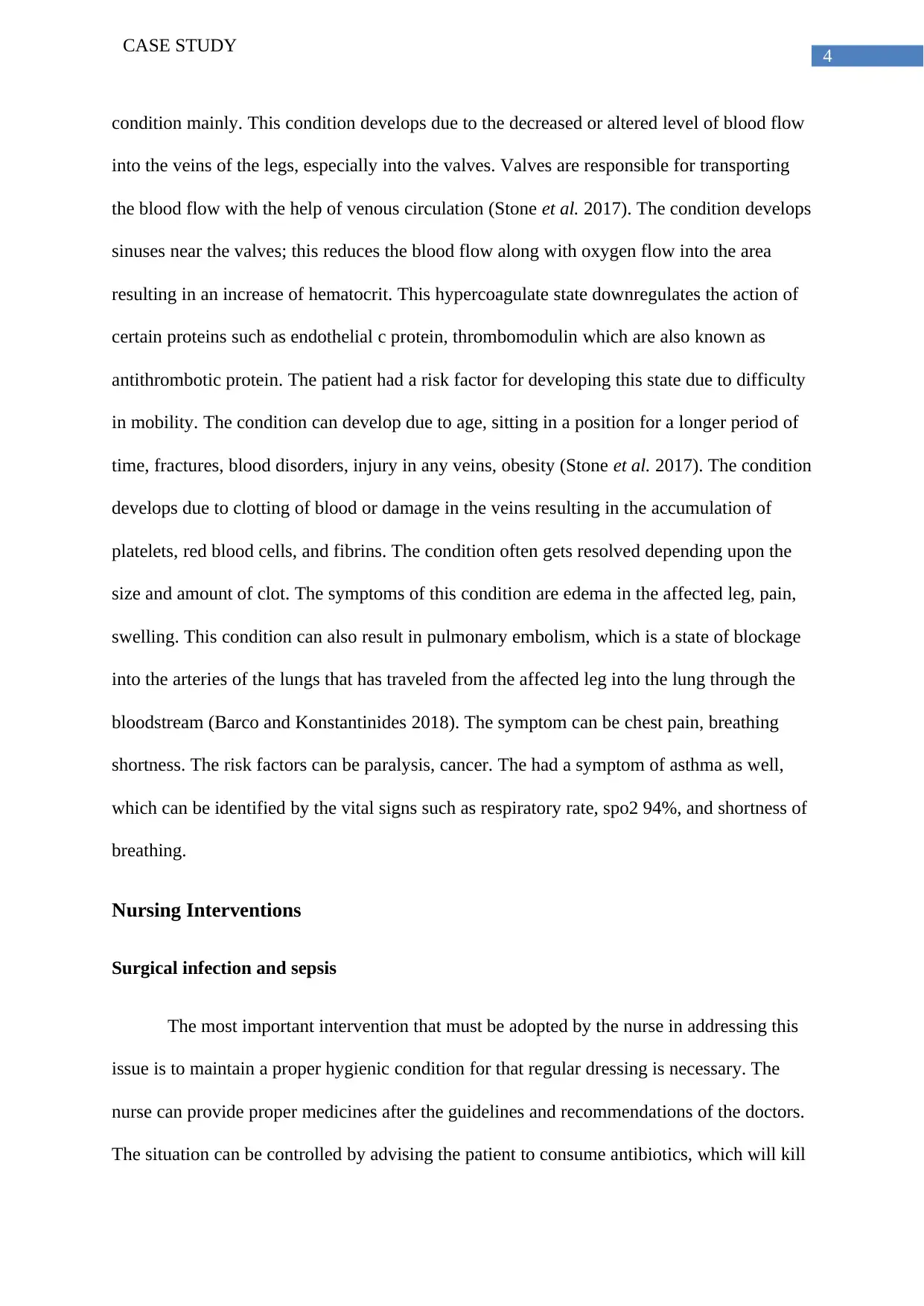
4
CASE STUDY
condition mainly. This condition develops due to the decreased or altered level of blood flow
into the veins of the legs, especially into the valves. Valves are responsible for transporting
the blood flow with the help of venous circulation (Stone et al. 2017). The condition develops
sinuses near the valves; this reduces the blood flow along with oxygen flow into the area
resulting in an increase of hematocrit. This hypercoagulate state downregulates the action of
certain proteins such as endothelial c protein, thrombomodulin which are also known as
antithrombotic protein. The patient had a risk factor for developing this state due to difficulty
in mobility. The condition can develop due to age, sitting in a position for a longer period of
time, fractures, blood disorders, injury in any veins, obesity (Stone et al. 2017). The condition
develops due to clotting of blood or damage in the veins resulting in the accumulation of
platelets, red blood cells, and fibrins. The condition often gets resolved depending upon the
size and amount of clot. The symptoms of this condition are edema in the affected leg, pain,
swelling. This condition can also result in pulmonary embolism, which is a state of blockage
into the arteries of the lungs that has traveled from the affected leg into the lung through the
bloodstream (Barco and Konstantinides 2018). The symptom can be chest pain, breathing
shortness. The risk factors can be paralysis, cancer. The had a symptom of asthma as well,
which can be identified by the vital signs such as respiratory rate, spo2 94%, and shortness of
breathing.
Nursing Interventions
Surgical infection and sepsis
The most important intervention that must be adopted by the nurse in addressing this
issue is to maintain a proper hygienic condition for that regular dressing is necessary. The
nurse can provide proper medicines after the guidelines and recommendations of the doctors.
The situation can be controlled by advising the patient to consume antibiotics, which will kill
CASE STUDY
condition mainly. This condition develops due to the decreased or altered level of blood flow
into the veins of the legs, especially into the valves. Valves are responsible for transporting
the blood flow with the help of venous circulation (Stone et al. 2017). The condition develops
sinuses near the valves; this reduces the blood flow along with oxygen flow into the area
resulting in an increase of hematocrit. This hypercoagulate state downregulates the action of
certain proteins such as endothelial c protein, thrombomodulin which are also known as
antithrombotic protein. The patient had a risk factor for developing this state due to difficulty
in mobility. The condition can develop due to age, sitting in a position for a longer period of
time, fractures, blood disorders, injury in any veins, obesity (Stone et al. 2017). The condition
develops due to clotting of blood or damage in the veins resulting in the accumulation of
platelets, red blood cells, and fibrins. The condition often gets resolved depending upon the
size and amount of clot. The symptoms of this condition are edema in the affected leg, pain,
swelling. This condition can also result in pulmonary embolism, which is a state of blockage
into the arteries of the lungs that has traveled from the affected leg into the lung through the
bloodstream (Barco and Konstantinides 2018). The symptom can be chest pain, breathing
shortness. The risk factors can be paralysis, cancer. The had a symptom of asthma as well,
which can be identified by the vital signs such as respiratory rate, spo2 94%, and shortness of
breathing.
Nursing Interventions
Surgical infection and sepsis
The most important intervention that must be adopted by the nurse in addressing this
issue is to maintain a proper hygienic condition for that regular dressing is necessary. The
nurse can provide proper medicines after the guidelines and recommendations of the doctors.
The situation can be controlled by advising the patient to consume antibiotics, which will kill

5
CASE STUDY
the disease-producing microorganism effectively and cure the symptoms. The planned drugs
must not affect the beneficial organisms present in the body. Cephalosporin and vancomycin
are effective against infectious bacteria named staphylococcus (Lai et al. 2017).
Ciprofloxacin can also help reduce the symptom. Vacuum-assisted closure can be used by the
nurse to heal the affected or wounded area, as this is helpful in increasing the flow of blood
and hence promote prompt healing (Yadav, Rawal and Baxi 2017). Acetaminophen and
ibuprofen can be used in reducing the fever symptoms. These drugs reduce or drop down the
fever by lowering the hormonal function of the body, which in turn reduces the inflammation
and pain. The patient was an older person with low immune capacity; in this case, the nurse
can provide and plan a diet that is protein-rich along with providing more fluid for draining
the bacteria from the body with the help of the excretory system, which will heal the
infectious state of the body. The nurse can also provide proper information about the disease
and its risk factors and assist the patient in maintaining a proper hygienic state for reducing
the chance of re-occurrence of this state (Haque et al. 2018). The nurse must also provide
medical asepsis to the patient, which will hinder the entry of bacteria and hence decreases the
threat of nosocomial infections. The vital signs need to be monitored, as well. The nurse can
also encourage the patient to relax in a comfortable position, taking deep breathing, which
will, in turn, decrease the respiratory compromise. The body temperature needs to monitored
as fever is nothing but an endotoxin effect on pyrogen-released endorphins and also
hypothalamus. The nurse can also administer recombinant human activated C protein, which
will be helpful in inhibiting the inflammation and promote fibrinolysis. Drotrecogin alpha is
one such example of this class (Annane et al. 2016). All these interventions will free the
patient from purulent secretion, erythema which in turn will be helpful in healing.
CASE STUDY
the disease-producing microorganism effectively and cure the symptoms. The planned drugs
must not affect the beneficial organisms present in the body. Cephalosporin and vancomycin
are effective against infectious bacteria named staphylococcus (Lai et al. 2017).
Ciprofloxacin can also help reduce the symptom. Vacuum-assisted closure can be used by the
nurse to heal the affected or wounded area, as this is helpful in increasing the flow of blood
and hence promote prompt healing (Yadav, Rawal and Baxi 2017). Acetaminophen and
ibuprofen can be used in reducing the fever symptoms. These drugs reduce or drop down the
fever by lowering the hormonal function of the body, which in turn reduces the inflammation
and pain. The patient was an older person with low immune capacity; in this case, the nurse
can provide and plan a diet that is protein-rich along with providing more fluid for draining
the bacteria from the body with the help of the excretory system, which will heal the
infectious state of the body. The nurse can also provide proper information about the disease
and its risk factors and assist the patient in maintaining a proper hygienic state for reducing
the chance of re-occurrence of this state (Haque et al. 2018). The nurse must also provide
medical asepsis to the patient, which will hinder the entry of bacteria and hence decreases the
threat of nosocomial infections. The vital signs need to be monitored, as well. The nurse can
also encourage the patient to relax in a comfortable position, taking deep breathing, which
will, in turn, decrease the respiratory compromise. The body temperature needs to monitored
as fever is nothing but an endotoxin effect on pyrogen-released endorphins and also
hypothalamus. The nurse can also administer recombinant human activated C protein, which
will be helpful in inhibiting the inflammation and promote fibrinolysis. Drotrecogin alpha is
one such example of this class (Annane et al. 2016). All these interventions will free the
patient from purulent secretion, erythema which in turn will be helpful in healing.
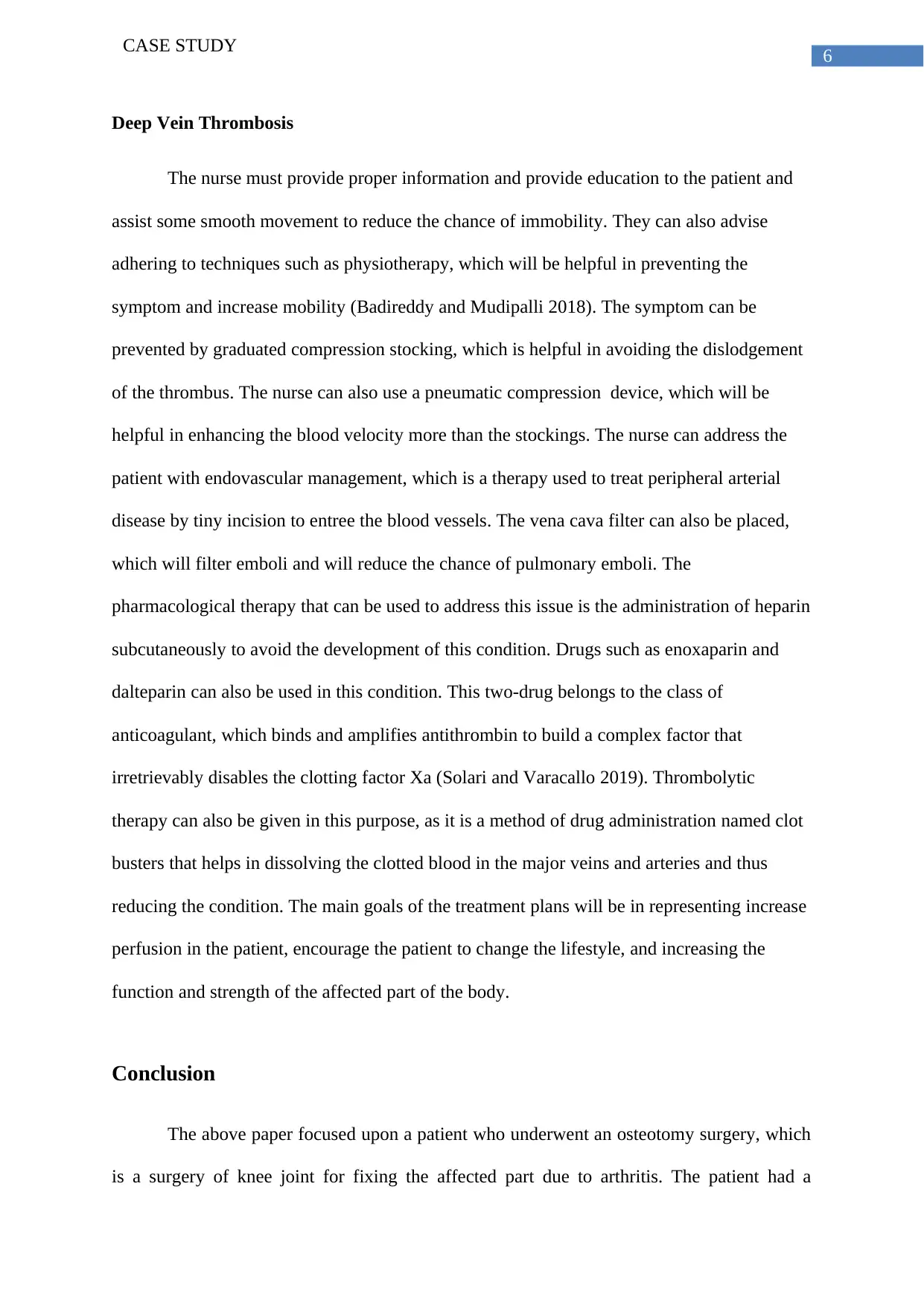
6
CASE STUDY
Deep Vein Thrombosis
The nurse must provide proper information and provide education to the patient and
assist some smooth movement to reduce the chance of immobility. They can also advise
adhering to techniques such as physiotherapy, which will be helpful in preventing the
symptom and increase mobility (Badireddy and Mudipalli 2018). The symptom can be
prevented by graduated compression stocking, which is helpful in avoiding the dislodgement
of the thrombus. The nurse can also use a pneumatic compression device, which will be
helpful in enhancing the blood velocity more than the stockings. The nurse can address the
patient with endovascular management, which is a therapy used to treat peripheral arterial
disease by tiny incision to entree the blood vessels. The vena cava filter can also be placed,
which will filter emboli and will reduce the chance of pulmonary emboli. The
pharmacological therapy that can be used to address this issue is the administration of heparin
subcutaneously to avoid the development of this condition. Drugs such as enoxaparin and
dalteparin can also be used in this condition. This two-drug belongs to the class of
anticoagulant, which binds and amplifies antithrombin to build a complex factor that
irretrievably disables the clotting factor Xa (Solari and Varacallo 2019). Thrombolytic
therapy can also be given in this purpose, as it is a method of drug administration named clot
busters that helps in dissolving the clotted blood in the major veins and arteries and thus
reducing the condition. The main goals of the treatment plans will be in representing increase
perfusion in the patient, encourage the patient to change the lifestyle, and increasing the
function and strength of the affected part of the body.
Conclusion
The above paper focused upon a patient who underwent an osteotomy surgery, which
is a surgery of knee joint for fixing the affected part due to arthritis. The patient had a
CASE STUDY
Deep Vein Thrombosis
The nurse must provide proper information and provide education to the patient and
assist some smooth movement to reduce the chance of immobility. They can also advise
adhering to techniques such as physiotherapy, which will be helpful in preventing the
symptom and increase mobility (Badireddy and Mudipalli 2018). The symptom can be
prevented by graduated compression stocking, which is helpful in avoiding the dislodgement
of the thrombus. The nurse can also use a pneumatic compression device, which will be
helpful in enhancing the blood velocity more than the stockings. The nurse can address the
patient with endovascular management, which is a therapy used to treat peripheral arterial
disease by tiny incision to entree the blood vessels. The vena cava filter can also be placed,
which will filter emboli and will reduce the chance of pulmonary emboli. The
pharmacological therapy that can be used to address this issue is the administration of heparin
subcutaneously to avoid the development of this condition. Drugs such as enoxaparin and
dalteparin can also be used in this condition. This two-drug belongs to the class of
anticoagulant, which binds and amplifies antithrombin to build a complex factor that
irretrievably disables the clotting factor Xa (Solari and Varacallo 2019). Thrombolytic
therapy can also be given in this purpose, as it is a method of drug administration named clot
busters that helps in dissolving the clotted blood in the major veins and arteries and thus
reducing the condition. The main goals of the treatment plans will be in representing increase
perfusion in the patient, encourage the patient to change the lifestyle, and increasing the
function and strength of the affected part of the body.
Conclusion
The above paper focused upon a patient who underwent an osteotomy surgery, which
is a surgery of knee joint for fixing the affected part due to arthritis. The patient had a
Paraphrase This Document
Need a fresh take? Get an instant paraphrase of this document with our AI Paraphraser
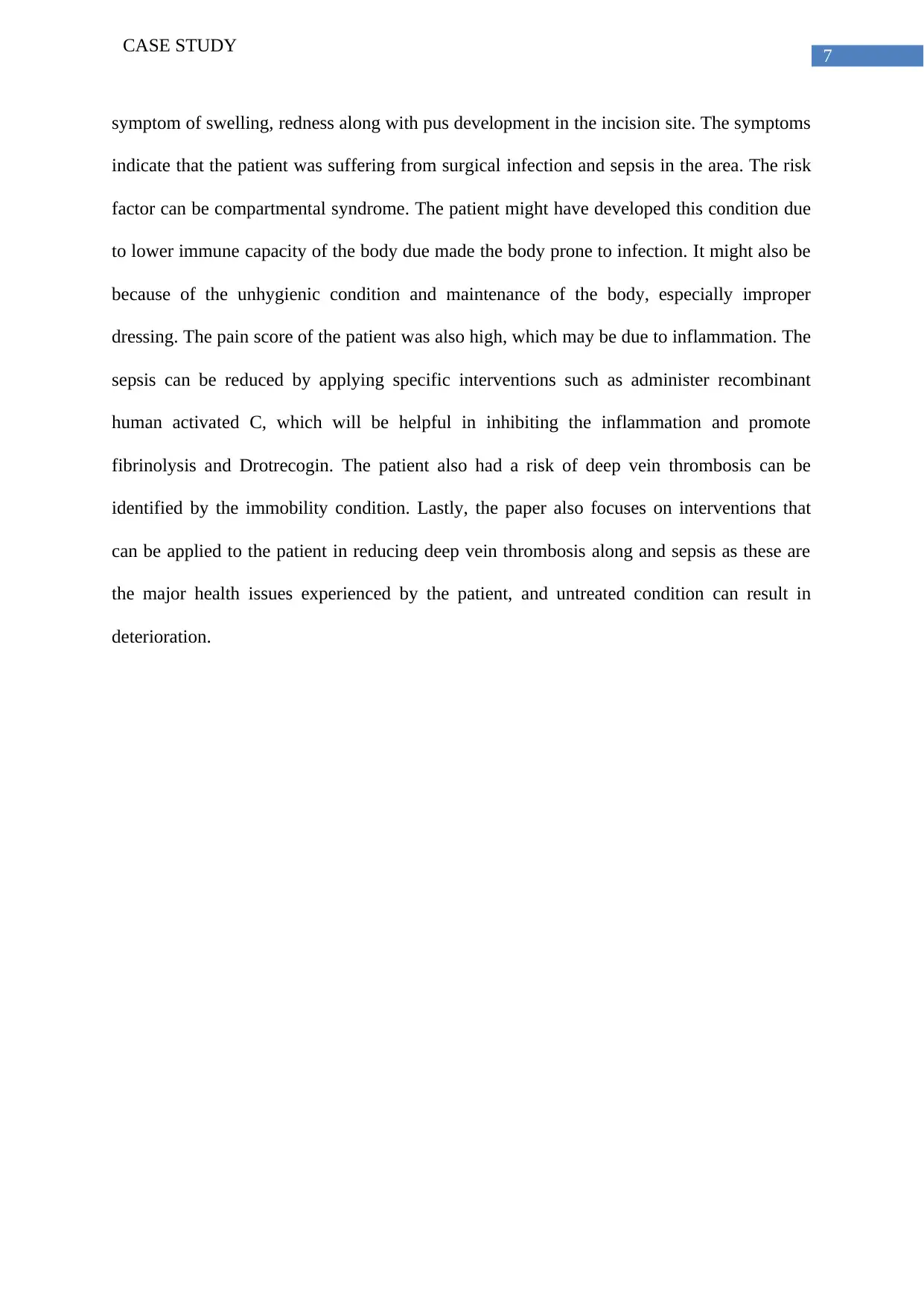
7
CASE STUDY
symptom of swelling, redness along with pus development in the incision site. The symptoms
indicate that the patient was suffering from surgical infection and sepsis in the area. The risk
factor can be compartmental syndrome. The patient might have developed this condition due
to lower immune capacity of the body due made the body prone to infection. It might also be
because of the unhygienic condition and maintenance of the body, especially improper
dressing. The pain score of the patient was also high, which may be due to inflammation. The
sepsis can be reduced by applying specific interventions such as administer recombinant
human activated C, which will be helpful in inhibiting the inflammation and promote
fibrinolysis and Drotrecogin. The patient also had a risk of deep vein thrombosis can be
identified by the immobility condition. Lastly, the paper also focuses on interventions that
can be applied to the patient in reducing deep vein thrombosis along and sepsis as these are
the major health issues experienced by the patient, and untreated condition can result in
deterioration.
CASE STUDY
symptom of swelling, redness along with pus development in the incision site. The symptoms
indicate that the patient was suffering from surgical infection and sepsis in the area. The risk
factor can be compartmental syndrome. The patient might have developed this condition due
to lower immune capacity of the body due made the body prone to infection. It might also be
because of the unhygienic condition and maintenance of the body, especially improper
dressing. The pain score of the patient was also high, which may be due to inflammation. The
sepsis can be reduced by applying specific interventions such as administer recombinant
human activated C, which will be helpful in inhibiting the inflammation and promote
fibrinolysis and Drotrecogin. The patient also had a risk of deep vein thrombosis can be
identified by the immobility condition. Lastly, the paper also focuses on interventions that
can be applied to the patient in reducing deep vein thrombosis along and sepsis as these are
the major health issues experienced by the patient, and untreated condition can result in
deterioration.
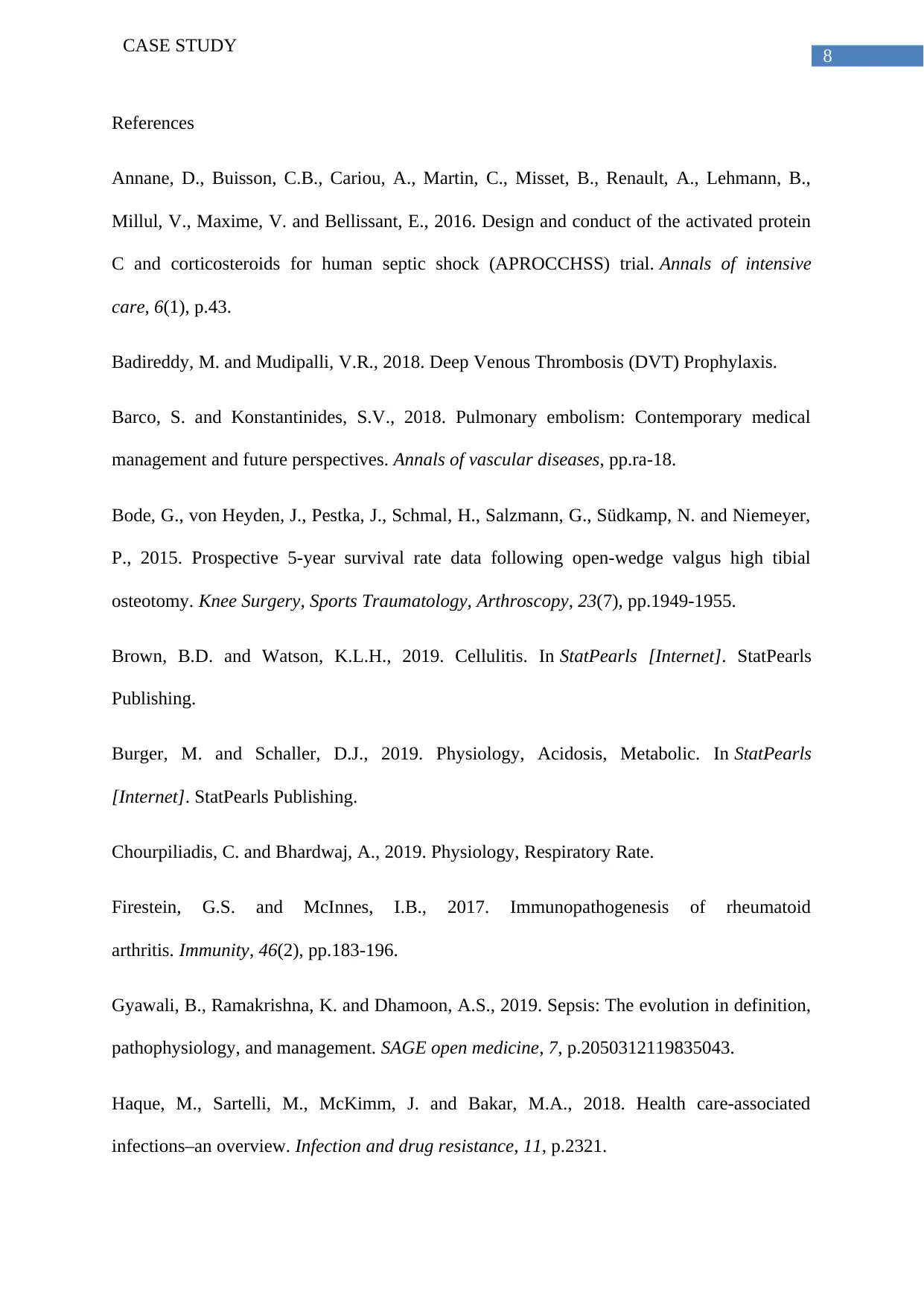
8
CASE STUDY
References
Annane, D., Buisson, C.B., Cariou, A., Martin, C., Misset, B., Renault, A., Lehmann, B.,
Millul, V., Maxime, V. and Bellissant, E., 2016. Design and conduct of the activated protein
C and corticosteroids for human septic shock (APROCCHSS) trial. Annals of intensive
care, 6(1), p.43.
Badireddy, M. and Mudipalli, V.R., 2018. Deep Venous Thrombosis (DVT) Prophylaxis.
Barco, S. and Konstantinides, S.V., 2018. Pulmonary embolism: Contemporary medical
management and future perspectives. Annals of vascular diseases, pp.ra-18.
Bode, G., von Heyden, J., Pestka, J., Schmal, H., Salzmann, G., Südkamp, N. and Niemeyer,
P., 2015. Prospective 5-year survival rate data following open-wedge valgus high tibial
osteotomy. Knee Surgery, Sports Traumatology, Arthroscopy, 23(7), pp.1949-1955.
Brown, B.D. and Watson, K.L.H., 2019. Cellulitis. In StatPearls [Internet]. StatPearls
Publishing.
Burger, M. and Schaller, D.J., 2019. Physiology, Acidosis, Metabolic. In StatPearls
[Internet]. StatPearls Publishing.
Chourpiliadis, C. and Bhardwaj, A., 2019. Physiology, Respiratory Rate.
Firestein, G.S. and McInnes, I.B., 2017. Immunopathogenesis of rheumatoid
arthritis. Immunity, 46(2), pp.183-196.
Gyawali, B., Ramakrishna, K. and Dhamoon, A.S., 2019. Sepsis: The evolution in definition,
pathophysiology, and management. SAGE open medicine, 7, p.2050312119835043.
Haque, M., Sartelli, M., McKimm, J. and Bakar, M.A., 2018. Health care-associated
infections–an overview. Infection and drug resistance, 11, p.2321.
CASE STUDY
References
Annane, D., Buisson, C.B., Cariou, A., Martin, C., Misset, B., Renault, A., Lehmann, B.,
Millul, V., Maxime, V. and Bellissant, E., 2016. Design and conduct of the activated protein
C and corticosteroids for human septic shock (APROCCHSS) trial. Annals of intensive
care, 6(1), p.43.
Badireddy, M. and Mudipalli, V.R., 2018. Deep Venous Thrombosis (DVT) Prophylaxis.
Barco, S. and Konstantinides, S.V., 2018. Pulmonary embolism: Contemporary medical
management and future perspectives. Annals of vascular diseases, pp.ra-18.
Bode, G., von Heyden, J., Pestka, J., Schmal, H., Salzmann, G., Südkamp, N. and Niemeyer,
P., 2015. Prospective 5-year survival rate data following open-wedge valgus high tibial
osteotomy. Knee Surgery, Sports Traumatology, Arthroscopy, 23(7), pp.1949-1955.
Brown, B.D. and Watson, K.L.H., 2019. Cellulitis. In StatPearls [Internet]. StatPearls
Publishing.
Burger, M. and Schaller, D.J., 2019. Physiology, Acidosis, Metabolic. In StatPearls
[Internet]. StatPearls Publishing.
Chourpiliadis, C. and Bhardwaj, A., 2019. Physiology, Respiratory Rate.
Firestein, G.S. and McInnes, I.B., 2017. Immunopathogenesis of rheumatoid
arthritis. Immunity, 46(2), pp.183-196.
Gyawali, B., Ramakrishna, K. and Dhamoon, A.S., 2019. Sepsis: The evolution in definition,
pathophysiology, and management. SAGE open medicine, 7, p.2050312119835043.
Haque, M., Sartelli, M., McKimm, J. and Bakar, M.A., 2018. Health care-associated
infections–an overview. Infection and drug resistance, 11, p.2321.
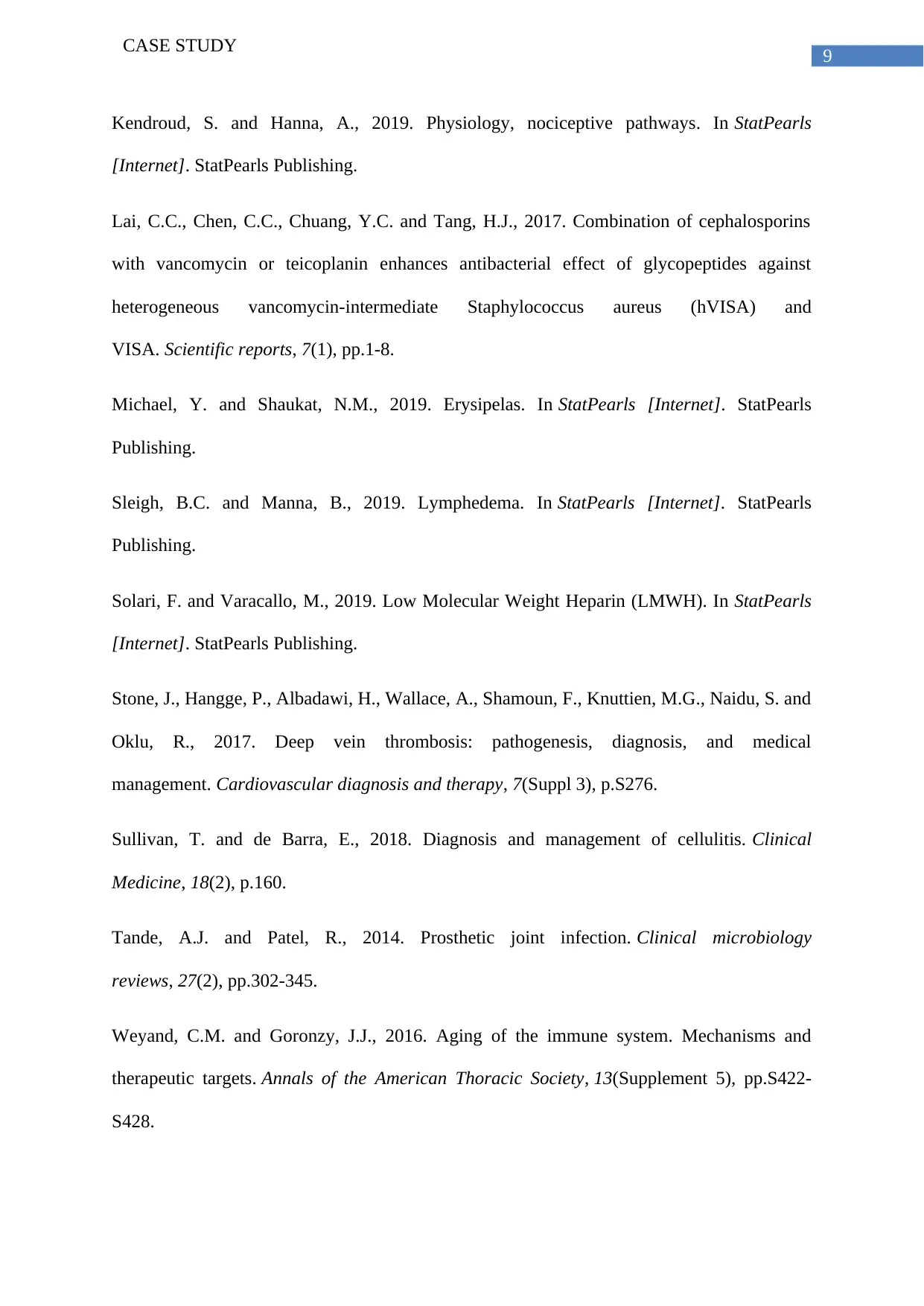
9
CASE STUDY
Kendroud, S. and Hanna, A., 2019. Physiology, nociceptive pathways. In StatPearls
[Internet]. StatPearls Publishing.
Lai, C.C., Chen, C.C., Chuang, Y.C. and Tang, H.J., 2017. Combination of cephalosporins
with vancomycin or teicoplanin enhances antibacterial effect of glycopeptides against
heterogeneous vancomycin-intermediate Staphylococcus aureus (hVISA) and
VISA. Scientific reports, 7(1), pp.1-8.
Michael, Y. and Shaukat, N.M., 2019. Erysipelas. In StatPearls [Internet]. StatPearls
Publishing.
Sleigh, B.C. and Manna, B., 2019. Lymphedema. In StatPearls [Internet]. StatPearls
Publishing.
Solari, F. and Varacallo, M., 2019. Low Molecular Weight Heparin (LMWH). In StatPearls
[Internet]. StatPearls Publishing.
Stone, J., Hangge, P., Albadawi, H., Wallace, A., Shamoun, F., Knuttien, M.G., Naidu, S. and
Oklu, R., 2017. Deep vein thrombosis: pathogenesis, diagnosis, and medical
management. Cardiovascular diagnosis and therapy, 7(Suppl 3), p.S276.
Sullivan, T. and de Barra, E., 2018. Diagnosis and management of cellulitis. Clinical
Medicine, 18(2), p.160.
Tande, A.J. and Patel, R., 2014. Prosthetic joint infection. Clinical microbiology
reviews, 27(2), pp.302-345.
Weyand, C.M. and Goronzy, J.J., 2016. Aging of the immune system. Mechanisms and
therapeutic targets. Annals of the American Thoracic Society, 13(Supplement 5), pp.S422-
S428.
CASE STUDY
Kendroud, S. and Hanna, A., 2019. Physiology, nociceptive pathways. In StatPearls
[Internet]. StatPearls Publishing.
Lai, C.C., Chen, C.C., Chuang, Y.C. and Tang, H.J., 2017. Combination of cephalosporins
with vancomycin or teicoplanin enhances antibacterial effect of glycopeptides against
heterogeneous vancomycin-intermediate Staphylococcus aureus (hVISA) and
VISA. Scientific reports, 7(1), pp.1-8.
Michael, Y. and Shaukat, N.M., 2019. Erysipelas. In StatPearls [Internet]. StatPearls
Publishing.
Sleigh, B.C. and Manna, B., 2019. Lymphedema. In StatPearls [Internet]. StatPearls
Publishing.
Solari, F. and Varacallo, M., 2019. Low Molecular Weight Heparin (LMWH). In StatPearls
[Internet]. StatPearls Publishing.
Stone, J., Hangge, P., Albadawi, H., Wallace, A., Shamoun, F., Knuttien, M.G., Naidu, S. and
Oklu, R., 2017. Deep vein thrombosis: pathogenesis, diagnosis, and medical
management. Cardiovascular diagnosis and therapy, 7(Suppl 3), p.S276.
Sullivan, T. and de Barra, E., 2018. Diagnosis and management of cellulitis. Clinical
Medicine, 18(2), p.160.
Tande, A.J. and Patel, R., 2014. Prosthetic joint infection. Clinical microbiology
reviews, 27(2), pp.302-345.
Weyand, C.M. and Goronzy, J.J., 2016. Aging of the immune system. Mechanisms and
therapeutic targets. Annals of the American Thoracic Society, 13(Supplement 5), pp.S422-
S428.
Secure Best Marks with AI Grader
Need help grading? Try our AI Grader for instant feedback on your assignments.

10
CASE STUDY
Yadav, S., Rawal, G. and Baxi, M., 2017. Vacuum assisted closure technique: a short
review. The Pan African medical journal, 28.
CASE STUDY
Yadav, S., Rawal, G. and Baxi, M., 2017. Vacuum assisted closure technique: a short
review. The Pan African medical journal, 28.
1 out of 11
Related Documents
Your All-in-One AI-Powered Toolkit for Academic Success.
+13062052269
info@desklib.com
Available 24*7 on WhatsApp / Email
![[object Object]](/_next/static/media/star-bottom.7253800d.svg)
Unlock your academic potential
© 2024 | Zucol Services PVT LTD | All rights reserved.





